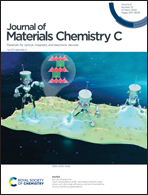Detection range extended 2D Ruddlesden–Popper perovskite photodetectors†
Abstract
Two-dimensional (2D) perovskite materials are a promising platform to construct high performance photodetectors due to their novel structure, high stability, resistance to ion migration and decent light harvesting ability. However, the detection range of 2D perovskite photodetectors is limited due to their large bandgap. Here, self-trapped states with a lower bandgap were created by introducing Sn into a 2D perovskite ((C6H5C2H4NH3)2PbI4, (PEA)2PbI4). Although previously the excitons in the self-trapped states have been regarded as localized excitons, an obvious photocurrent generated by the dissociation of excitons in self-trapped states has been observed. With this property, the detection range of 2D perovskite photodetectors has been successfully extended. Additionally, the special 2D structure of (PEA)2PbI4 endows the device with high stability and great resistance for ion migration to endure long-term (over 1000 s) consistent work without degradation in performance. This facile doping method for extending the detection range of 2D perovskite photodetectors will greatly broaden their application potential.



 Please wait while we load your content...
Please wait while we load your content...